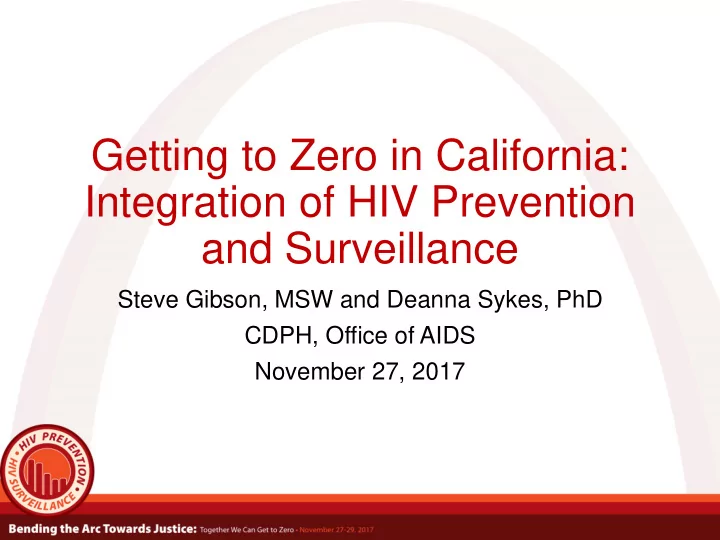

Getting to Zero in California: Integration of HIV Prevention and Surveillance Steve Gibson, MSW and Deanna Sykes, PhD CDPH, Office of AIDS November 27, 2017
Learning Objectives • Understand reasons for integrated HIV Surveillance and Prevention plan • Identify HIV Surveillance and HIV Prevention activities • Clarify expectations and timeline to respond to HIV prevention funded program activities under the new CDC Funding Opportunity
A New Era
A Sixth Major Change: • ELR: Surveillance data is more complete, more accurate, and more timely. Interventional Surveillance
Surveillance as Prevention • Interventional Surveillance : Using surveillance data to intervene – e.g., Data to Care, Surveillance-based partner services • Using surveillance data to assess progress in Getting to Zero (8 of 12 objectives) • Result is need for: • More collaboration • More complete, accurate and timely data • More connected data and systems
Message to Surveillance Coordinators: We are in a new era. Surveillance and prevention must collaborate in order to achieve Getting to Zero goals. Listen, ask questions, and consider how we can “fit together” to achieve our goals.
ART as Prevention Scientific advances have shown that antiretroviral therapy (ART) preserves the health of people living with HIV. We also have strong evidence of the prevention effectiveness of ART...Across three different studies, including thousands of couples and many thousand acts of sex without a condom or pre-exposure prophylaxis (PrEP), no HIV transmissions to an HIV-negative partner were observed when the HIV-positive person was virally suppressed.
ART as Prevention (con’t) This means that people who take ART daily as prescribed and achieve and maintain an undetectable viral load have effectively no risk of sexually transmitting the virus to an HIV-negative partner. (CDC, Dear Colleague, September 27, 2017)
California’s Continuum of HIV Care – 2015 100% 94% 100% 90% 80% 67% 70% Living with HIV (%) 57% 60% 50% 50% 40% 30% 20% 10% 0% HIV INFECTED DIAGNOSED IN HIV RETAINED IN ACHIEVED (ESTIMATED) (N=128,415) CARE HIV CARE VIRAL (N=137,342) (N=92,373) (N=69,094) SUPPRESSION (N=78,134) Stage of HIV Care
PrEP in CA The CDC defined an indication for PrEP in CA among three priority populations: • Gay men and other MSM • High-risk heterosexually active adults • People who inject drugs (PWID)
PrEP in CA
PS18-1802: Integrated HIV Surveillance and Prevention Programs for Health Departments Component A (non-competitive allocation) Budget: $18,090,453 - $19,994,712 California Project Area (CPA) • 20 Local Health Jurisdictions (LHJs) • 93% HIV Prevalence within CPA Component B: (competitive demonstration project) • $2 million requested to implement same-day PrEP for MSM of color and transgender women
What’s New for HIV Prevention • Funding to include 20 LHJs with San Mateo and Marin joining the CPA • CDC allocations based on zip code of residence rather than diagnosis • CDPH/OA Prevention allocation to remain unchanged in 2018 • CDPH/OA will initiate process to review the funding allocation formula beginning late 2017 or early 2018 • Program Guidance in development
California Project Area (CPA)
Prevention Program Implications During the transition year (2018) programs must determine how they will implement the following required activities: • Increase routine, opt-out HIV testing in healthcare settings • Support syringe services programs (SSP) • Implement and/or increase navigation services to health insurance, PrEP, STD services, and HIV care and treatment to achieve viral suppression.
Prevention Program Implications During the transition year (2018) programs must determine how they end the following activities that will no longer be funded: • Targeted HIV testing in sites that have not found a newly identified confirmed HIV positive case in the last three years • Risk reduction activities (RRA)
Supporting SSPs LHJs with authorized SSPs will strengthen SSP capacity to deliver comprehensive HIV prevention services to people who inject drugs. Examples include: • Increase SSP staffing levels • Overdose prevention and providing naloxone • Integrated HIV/HCV testing • Vaccinations for viral hepatitis
Supporting SSPs (con’t) If an LHJ includes an authorized SSP, but wishes to opt out of the SSP requirement, a strong justification must be submitted to OA. LHJs with no authorized SSP will conduct a community readiness assessment to determine local capacity for: • Establishing SSP and/or • Establishing or expanding non-prescription syringe sale in pharmacies.
HIV Prevention Branch Expectations • Continue 2017 contract monitoring • Provide TA to LHJs to assess capacity and readiness to implement new program activities (webinars, site visits, conference calls, etc.) • Develop new data collection forms based on CDC new variables • Issue Budget Guidance • Develop new contracts for 2019 - 2021
LHJ Expectations • Close out 2017 activities • Participate with OA to assess capacity and readiness to implement new program activities • Respond to 2018 Transition Plan • Develop new prevention program activities • Initiate new contracts for 2019 - 2021
Timeline Nov – Dec 2017 Continue 2017 activities Jan – Feb, 2018 OA release Program Guidance and 2018 Transition Plan and Budget template OA to provide TA Mar – Jun, 2018 LHJs respond to 2018 Transition Plan Develop new programmatic activities Jul – Dec 2018 Draft new contracts to begin Jan 2019 Jan 2019 – Dec 2022 Implement and monitor new program activities
Questions?
Contact Information Steven Gibson Steven.Gibson@cdph.ca.gov 916-552-9926 Deanna Sykes Deanna.Sykes@cdph.ca.gov 916-449-5835
Recommend
More recommend